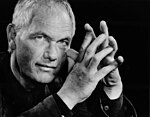User:Amirfreimann/sandbox
Victor Halvani | |
|---|---|
 Victor Halvani | |
| Born | 1930 (age 93–94) [[Giza, Egypt]] |
| Nationality | Israeli |
| Known for | Sculpture |
| Notable work | Jacob's Dream, Jacob Javits Center, NYC; The Spies, at the Halvani Square, and Halvani Sculpture Park, Safed, Israel; David Playing the Harp, Ein Hod, Israel |
| Movement | Realism |
[[Jacob's Dream]]


Victor Halvani (born 1930)[1] is an Ein Hod-based Israeli contemporary figurative/abstract artist known for his bronze sculptures.
Career[edit]
In 1953, 4 years after his arrival in Israel from Egypt, Halvani received scholarship and year of study at Bezalel Academy of Arts and Design in Jerusalem. In 1956 he finished education studies and received BA in education from the Tel Aviv Art Teachers College. In 1969 Halvani received a scholarship to study abroad for a year at Hammersmith College of Art and Building in London, graduating cum laude. In 1970 he received MA in art education and sculpture from the Levinsky College of Education.
Educated in painting and illustration at the Art Center College of Design, MacDonald was successful as a commercial illustrator until his late thirties when a fire destroyed his studio, along with the accumulated works of his career as painter and illustrator.[2] Subsequently, he began sculpting in earnest and within ten years became one of the most collected present-day figurative sculptors in America. His work has been acquired for the permanent collections of corporations such as AT&T, IBM, and Anheuser-Busch, as well as notable private collections.[3] His work has been described as "paying tribute to the eloquence of the human form."[4] He is an advocate of neo-realism and figurative art, and has fostered emerging and professional artists through annual international Masters Workshops.[5]
Method[edit]

MacDonald's work portrays "the beauty of the human body and the spirit that drives it."[4] He works consistently with models throughout the process of creating a sculpture, often celebrated dancers, performers, and athletes. MacDonald draws and sculpts his subjects over and over, often requiring models to repeat a specific dance move or spontaneous gesture. This may include small, quick sketches in an oil-base plasticine clay that are refined and enlarged. A mold is used to create editions in bronze through the "lost wax" technique. For each of MacDonald's work he creates the final patina or surface coloration that is subsequently duplicated by the patina artists on his staff for the remainder of the edition. The final patinated bronze is affixed to a marble base, also designed and selected by the artist as part of the overall sculptural composition.[3][4]
Monuments[edit]
The Flair[edit]
For the 1996 Summer Olympics, MacDonald created The Flair, a 26-foot-tall sculpture of a gymnast. As with all the monuments he has completed, MacDonald designed the plaza on which The Flair sits, including a large reflective pool and fountain.[6]
U.S. Open Golf Championship[edit]
The 15-foot-tall, 10,000-pound sculpture sits atop a 22,000-pound granite base, installed at the Peter Hay Golf Course in Pebble Beach, California to commemorate the 100th U.S. Open Golf Championship. The sculpture accurately portrays the mechanics of an ideal golfer swing. The granite base features the names of the first 100 winners of the U.S. Open. The reverse side provides space for the next hundred winners.[7]
The Royal Ballet School[edit]
MacDonald has started work on The Grand Coda, a memorial to Dame Ninette de Valois, founder of The Royal Ballet and The Royal Ballet School. The monument is to be installed at White Lodge in Richmond Park, London, England, a historic royal retreat that is now home to The Royal Ballet School. This work-in-progress is currently in development at the artist's studios in California and London. [8]
Additional commissions[edit]
Additional monument commissions include: Rain, City of Concord, California, 1992; Secretary of State William H. Seward, Z. J. Loussac Public Library, Anchorage, Alaska, 1990; Architectonica, MGM Film Group, Inc., MGM Corporate Center, 1987; Stephen F. Austin, Texas Susquicentennial, Stephen F. Austin University, Austin, Texas, 1986; and The Gymnast, permanent collection of The National Art Museum of Sport, 1986.[3]
References[edit]
- ^ http://halvani.com/the-seeds-of-art/.
{{cite web}}: Missing or empty|title=(help) - ^ Beguiled by the Figure by Jonathon Keats, Art & Antiques Magazine, 2007
- ^ a b c Richard MacDonald, Fall, 2002, Sculpture Review Magazine.
- ^ a b c Metal Guru by Ryan Masters, Monterey County Weekly Magazine, May 19, 2005
- ^ Carving Beauty into the Lives of Others by Charleen Earley, 65 Degrees Magazine, Winter, 2009
- ^ USG Statues Georgia Info, State of Georgia
- ^ USA Today article, June 19, 2000
- ^ Top sculptor to create Memorial to Founder of The Royal Ballet School 15 September 2010
- Cirque du Sculpture, American Art Collector Magazine, 2007
- Spirit of Life by Laurie McLaughlin, ArtSpace Magazine, December 2006
- Richard MacDonald, Collected Works by RMD, Hudson Hills Press
- Southern Accents Magazine, November/December 1984
- Art Talk, January 1996
- American Artist Magazine, August 1996
- Southwest Art Magazine, July 1997
- American Artist Magazine, November 1999
- Richard MacDonald Sculpture, September 1999
- The World and I, Vol. 16, No. 5, 2001
Sources[edit]
- Richard MacDonald, 1999, Gardner Lithograph Press ISBN 0-9673425-0-3
- City of Art, Kansas City’s Public Art, 2001
- International Encyclopedia Dictionary of Modern and Contemporary Art, 2000-2001
- New Mexico Millennium Collection, 2002
External links[edit]
Category:1930 births Category:Israeli sculptors Category:Living people Category:Art Center College of Design alumni

